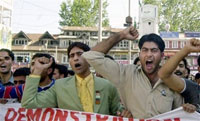Indian police release sketches of three suspects in courthouse blasts
Indian police released sketches of three suspects in planting time bombs on bicycles that killed at least 16 people in three Indian cities.

Another 59 others, mostly lawyers, were injured in Friday's blasts in Varanasi , Lucknow and Faizabad, in Uttar Pradesh state.
"These sketches were made on the basis of descriptions given by the eyewitnesses. All the persons seem to be in their late twenties. They parked their bicycles, laden with explosives, near the advocates' makeshift chamber and left," Vikram Singh, the director general of police told The Associated Press on Saturday.
Two sketches were released in Lucknow, the state capital and another in Faizabad, he said.
He said it was not unusual for people to park bicycles near the law offices.
At least 11 lawyers were killed and 45 people were wounded in three explosions in Varanasi, one of Hinduism's holiest cities, while five people died in twin blasts in Faizabad, near the town of Ayodhya, where Hindu extremists destroyed the 16th century Babri Mosque in 1992, sparking widespread Hindu-Muslim riots.
Brij Lal, a senior police official, said the police investigation was centered around the new bicycles used in the blast. "Police are trying to locate the shops from where these bicycles were purchased," he said.
Federal authorities blamed militants trying to spark unrest between India 's Hindu majority and Muslim minority, though a legal group noted all of Friday's blasts came in a state where lawyers had decided not to defend terrorism suspects.
The state's top elected official Mayawati, who uses one name, criticized federal intelligence agencies for failing to anticipate the attacks. "There was no warning to us from the federal government," she said late Friday.
Vipin Mishra, spokesman for the state's Home Ministry, said the blasts went off less than 15 minutes apart inside court complexes.
Indian court complexes are crowded, chaotic places, with lawyers often setting up small outdoor "offices" in makeshift, open-walled shacks built in courtyards. Some of the bombs apparently went off in such courtyards.
"It's a conspiracy ... this is the handiwork of some group that wants to disturb communal harmony in the country," the junior federal home minister, Sriprakash Jaiswal, told reporters. "They may have targeted the courts because large crowds gather in courthouses here."
But Padam Kriti, a spokesman of the Uttar Pradesh Bar Association, said the state's lawyers had decided earlier this year not to defend any terror suspects, and "it looks like" that decision may have been behind the blasts.
A series of terrorist bombings have ripped across India in the past two years. In August, a pair of explosions killed 43 people in the southern city of Hyderabad . In July 2006, bombs in seven Mumbai commuter trains killed more than 200 people.
Subscribe to Pravda.Ru Telegram channel, Facebook, RSS!




